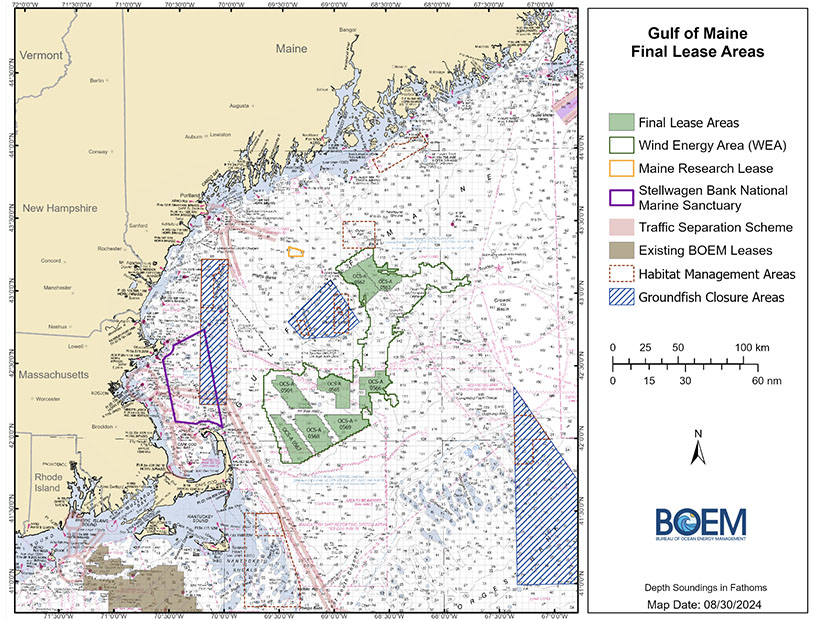The U.S. Bureau of Ocean Energy Management announced Sept. 16 it will conduct an offshore wind energy lease sale on Oct. 29 for eight areas on the Outer Continental Shelf in the Gulf of Maine.
The gulf stretches from Cape Cod to Nova Scotia and the leases include areas off Massachusetts near Boston, New Hampshire and Maine. Unlike the rest of the East Coast, the Gulf of Maine has waters that are too deep for traditional offshore wind, so any projects would have to use floating turbines.
The announcement comes less than a month after U.S. Department of the Interior and BOEM announced a “research lease” that will allow the state of Maine build up to 12 floating turbines that could produce 144 MW. (See Maine Approved for Floating Wind Research Lease.)
“The growing enthusiasm for the clean energy future is infectious,” said Interior Secretary Deb Haaland. “Today’s announcement — which builds on the execution of the nation’s first floating offshore wind energy research lease in Maine last month — is the result of years of thoughtful coordination between our team, the Gulf of Maine states, industry and the Tribes and ocean users who share our interest in the health and longevity of our ocean.”
The leases could produce about 13 GW of offshore wind power if fully developed, which could power more than 4.5 million homes. Since the beginning of the Biden administration, BOEM has held five offshore wind lease sales and approved 10 commercial-scale offshore wind projects.
The announcement is based on the best available science, including an ecosystem-based spatial suitability model conducted by the National Centers for Coastal Ocean Science. BOEM also spent more than two years engaging with Tribes, the fishing industry and other stakeholders across the region to help shape the lease areas.
The overall area is about 120,000 acres less than what BOEM included in its proposed sale notice that was announced earlier this year. The bureau tried to avoid offshore fishing grounds, sensitive habitats, and existing and future vessel transit routes, while retaining enough acreage to support the region’s offshore wind energy goals.
Winning a lease does not confer the right to build an actual power plant, but it gives developers the right to submit project specific plans that would be subject to environmental, technical and public reviews before any approvals.
BOEM has identified 14 firms that are legally, technically and financially qualified to bid in the lease auction: Avangrid Renewables, Equinor Wind US, US Mainstream Renewable Power, Diamond Wind North America, Hexicon USA, Seaglass Offshore Wind II, TotalEnergies SBE US, Pine Tree Offshore Wind, energyRe Offshore Wind Holdings, OW Gulf of Maine, Repsol Renewables North America, Maine Offshore Wind Development, Corio USA Projectco and Invenergy NE Offshore Wind.
Bidders wishing to participate have to file financial forms by Sept. 27 and post $2 million deposits for each lease area they plan to bid on (up to a maximum of two) by Oct. 11.



